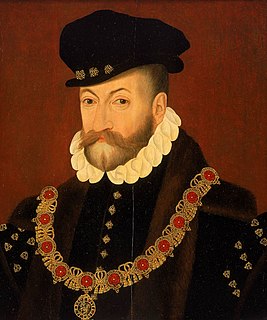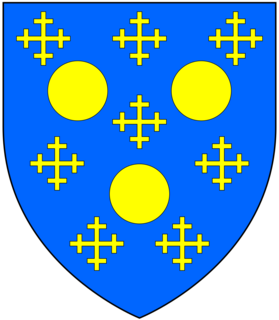
The coronation of the British monarch is a ceremony in which the monarch of the United Kingdom is formally invested with regalia and crowned at Westminster Abbey. It corresponds to the coronations that formerly took place in other European monarchies, all of which have abandoned coronations in favour of inauguration or enthronement ceremonies.
Earl of Dundee is a title in the Peerage of Scotland. It was created in 1660 for John Scrymgeour, 3rd Viscount Dudhope. At his death in 1668, the Duke of Lauderdale declared that the first Earl had no heirs-male, and had the crown seize all of his lands. The earldom of Dundee became dormant and its holdings and offices were granted to Charles Maitland, 3rd Earl of Lauderdale, the Duke's younger brother. The title was revived in 1953, when it was determined that the first Earl did indeed have heirs-male, contrary to the assertion of the crown. The title was given to Henry James Scrymgeour-Wedderburn, who had previously served in the House of Commons and in the Cabinet.

Edward Fiennes, or Clinton, 1st Earl of Lincoln KG was an English landowner, peer, and Lord High Admiral. He rendered valuable service to four of the Tudor monarchs.

Under feudalism in France and England during the Middle Ages, tenure by serjeanty was a form of tenure in return for a specified duty other than standard knight-service.

Scrivelsby is a village and ecclesiastical parish in the East Lindsey district of the County of Lincolnshire, England. It is situated 2 miles (3.2 km) south of Horncastle and is on the B1183 road 1 mile (1.6 km) east from the A153 road. It is administered by the civil parish of Mareham on the Hill.

The Dymoke family of the Manor of Scrivelsby in the parish of Horncastle in Lincolnshire holds the feudal hereditary office of King's Champion. The functions of the Champion are to ride into Westminster Hall at the coronation banquet and challenge all comers who might impugn the King's title.

Baron FitzHugh, of Ravensworth in North Yorkshire, is an abeyant title in the Peerage of England. It was created in 1321 for Sir Henry FitzHugh. The title passed through the male line until the death in 1513 of George FitzHugh, 7th Baron FitzHugh, when it became abeyant between his great-aunts Alice, Lady Fiennes and Elizabeth, Lady Parr, and to their descendants living today, listed below. The family seat was Ravensworth Castle in North Yorkshire, situated 4.5 miles north-west of Richmond Castle, caput of the Honour of Richmond, one of the most important fiefdoms in Norman England.
The Standard Bearer of England was once an important office within the English army, especially during the times when Kings were still present on the battlefield. As standard-bearer Henry de Essex was greatly chastised when he threw down the English Standard and claimed his King (Stephen) was dead in 1153.

Robert Dymoke, Dymock or Dymocke, of Scrivelsby, Lincolnshire was Queen's Champion of England and a devout Catholic recusant who was named a martyr after his death.
The Rev. Samuel Lodge was the author of Scrivelsby, the Home of the Champions He was a headmaster of Horncastle Grammar School, Lincolnshire, rector for 30 years of Scrivelsby in Lincolnshire, and a Canon of Lincoln Cathedral.

Sir William Coffin was a courtier at the court of King Henry VIII of England. He was a Gentleman of the Privy Chamber to King Henry VIII and Master of the Horse to Queen Jane Seymour. He was elected MP for Derbyshire in 1529.
Margaret Dymoke was a lady-in-waiting at the court of Henry VIII of England. Her married names were Vernon, Coffin and Manners. She was born around 1500 in Scrivelsby, Lincolnshire, the daughter of Sir Robert Dymoke of Scrivelsby and Jane Cressner. Her first husband was Richard Vernon of Haddon (d. 1517), by whom she had at least two children. Her second husband was Sir William Coffin, Master of the Horse to Anne Boleyn, the second wife of Henry VIII.
Thomas Christopher Banks (1765–1854), who for a while styled himself by the bogus title "Sir T.C. Banks, Baronet of Nova Scotia" was a British genealogist and lawyer. He is notorious for having assisted several claimants to dormant peerages, based on the very flimsiest evidence, which he strengthened with imaginary pedigrees. During his later years he resided near Ripon, Yorkshire.
Marmion is a surname found in France, Great Britain and Ireland, of Norman-French origin. The origin of the surname itself is disputed.
Sir Henry Dymoke, 1st Baronet, was a British landowner and the hereditary King's Champion.

Baron Bardolf or Bardolph was a title in the Peerage of England.

There have been four different baronies held by the Marmion family, two feudal baronies, one purported barony created by Simon de Montfort and one barony by writ.
Lieutenant-Colonel John Lindley Marmion Dymoke MBE was the hereditary Queen's Champion from 1946 until his death in 2015. He was present, as champion, at the Coronation of Queen Elizabeth II in 1953 and acted as Standard-Bearer of the Union Flag.
Sir John Marmion, Baron Marmion of Winteringham was an Anglo-Norman baron who represented Lincolnshire in Parliament and fought in the Wars of Scottish Independence.
Dymoke family of the Manor of Scrivelsby in the parish of Horncastle in Lincolnshire, holder of the feudal hereditary office of King's Champion with functions including to ride into Westminster Hall at the coronation banquet, and challenge all comers who might impugn the King's title.









